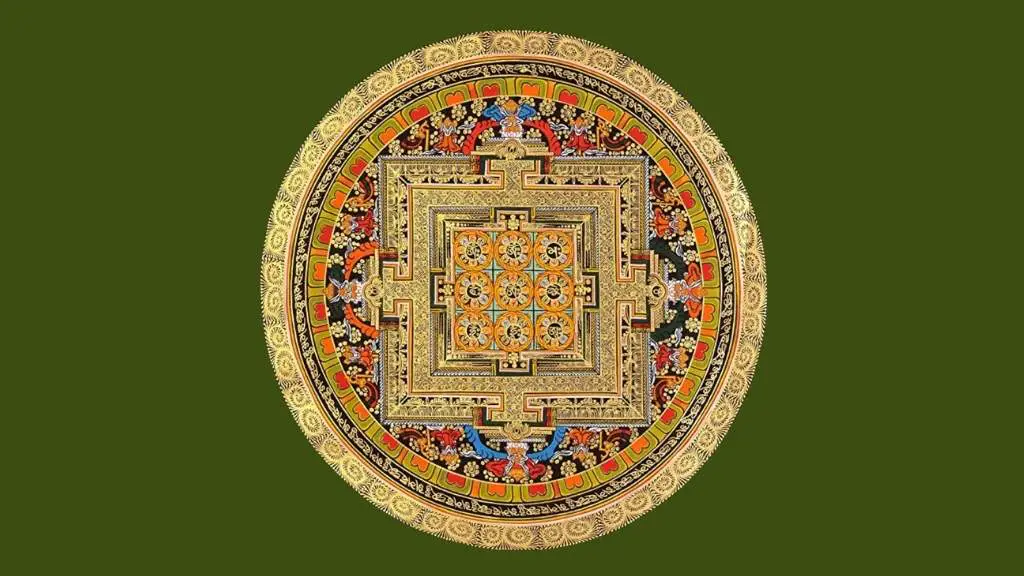The Tibetan Buddhist sand mandalas first arrived in San Luis Obispo more than a dozen years ago. Since then they have become something of an institution on the Central Coast. No one who observes the creation of these exquisite works of art can fail to appreciate the concentration and devotion that go into them.
The unique process, the unusual materials, the striking composition and the surprise ending make the Buddhist sand mandalas fascinating in every way. And the more you know about the monks, their religion and their mandalas, the more you can appreciate the significance of it all.
What is a Buddhist Sand Mandala?
As part of an ancient tradition, Buddhist monks from Tibet and Northern India (where many Tibetans remain living in exile) travel the globe producing these mandalas for all the world to see. The monks create these designs as a way to raise awareness about their culture, but also as part of a pious meditation.
Using sand of different colors, several disciples spend the better part of a week putting the picture together, roughly one grain of sand at a time. By the end of the week, they have created a spectacular image of an archetypal symbol. Buddhists, Jungians and dreamers of every stripe recognize the mandala, usually a circle inscribed inside of a square inside of a larger circle.
Once the multicolored masterpiece is complete, the monks conduct a quiet, reverent ceremony, with a bit of chanting and mindful reflection. At last, the creators of this ephemeral artwork carry the mandala away and peacefully dump the colored sand into a nearby creek. Meanwhile, onlookers gasp with disbelief and unease as the product of profound punctiliousness is washed away.
What is the meaning of the Mandala?
The symbolism of the mandala is deep and mysterious. An icon of sacred geometry, the interlocking circles and squares serve as a kind of window into the universe. And others will interpret the cryptic image as a portal into the human soul.
Typically, Buddhist practitioners can use a mandala as a kind of talisman or focal point for their meditation. Gazing into the central circle can help to quiet the mind and bring the disciple in tune with the unblemished Self.

The ornate, abstract imagery gives the eye a place to focus. And spiraling into the middle circle, the practitioner can grow more self-aware on one hand, but also conscious of his/her position at the center of something infinite.
States of Consciousness
Another reading, which I’m very sympathetic to, describes the small circle as the earliest stage of consciousness. This is the condition of bliss before the infant mind has learned to distinguish between subject and object. The child is connected to all things in a state of “unconscious perfection.”
As a person ages, they learn to distinguish between pairs of opposites, something like Adam and Eve after the Fall. Older and more mature, the individual begins to divide the world of experience into different categories, good or bad, right or wrong, and so on. They see things as separate and distinct. The four-sided square represents this state of rational awareness, or “conscious imperfection.”
This state of mind persists through most of adulthood. But with extensive spiritual development, one can expand their consciousness into the larger circle. This expanded circle represents the undifferentiated whole, the field in which all things are connected. The devotee has arrived in the realm of “conscious perfection.”
This version of the mandala resonates for me because it feels consistent with so many other examples from world religions. Consider the parallel, for example, between circle-square-circle and birth-death-rebirth. It is a story as ancient as that of the complacent orphan who is lost, then called on an adventure, and finally returns as a hero.
The levels of metaphor run deep. And throughout the picture of the mandala, the imagery of steps and concentric circles would seem to reinforce that metaphor. And if this isn’t a concept worthy of profound meditation, then I don’t know what is.
Why do they create with sand?
You can find mandalas in many forms, in murals, jewelry and coloring books. But there is clearly something special about a mandala, usually 10 or 12 feet in diameter, that is made entirely of colored sand.
Few things in our world of sight and touch are smaller than a grain of sand. By itself, the grain of sand is infinitesimally insignificant. This makes the process of creation incredibly slow and fastidious. It forces the artist to slow down.
Just as Alcoholics Anonymous invites its members to take life “One step at a time”, the sand mandala requires one to proceed one grain at a time. At this pace, the monk can feel the whole world slowing down. And in doing so, his awareness gradually elevates, to a heightened state of consciousness.
In this state of mind, the concentrating monk might consider the many paradoxes of the human condition. S/he might think about the simultaneous greatness and smallness of all things. Like the Yin-Ying that reveals the coexistence of darkness and light, the sand mandala reveals a special balance of the microscopic and the macroscopic.
A Higher Order
Another metaphor at work here reminds us of just how small we are within the universe. And though this can make us feel terribly trivial and insignificant, we can also see our importance in the big picture. What is the universe after all, but a careful arrangement of tiny, innumerable units?
On their own, each grain of sand seems worthless and unimportant. But they make up everything. And the end result is a whole much greater than the sum of its parts. It’s not just a heap of insignificant grains; it’s a beautiful, mesmerizing mandala.
We can find a similar analogy in the ordinary ant colony. Individually, each ant is almost nothing. They would never accomplish anything. But in numbers, the colony takes on a higher intelligence of its own. Through an organization that no single ant could ever comprehend, the colony can literally move mountains.
Why do they destroy the Sand Mandala?
At the end of the week comes what some may consider the highlight of the process. Others might find it painfully anti-climactic. In a bold move, the monks pick up their masterpiece and pour it down the river.
How could they destroy their artwork following so many painstaking days of meticulous construction? After those long hours of putting the mandala together, one grain at a time, they just let the whole thing go.

I can imagine no more perfect embodiment of the Buddhist tenet of non-attachment. The ability to let go of attachments to ideas and objects is central to Buddhist philosophy. The creation of the mandala is all about the process, not the end result. Or as the Taoist proverb says, “The journey is the reward.”
Impermanence
When we take the long view, we see that all things are impermanent. Everything comes and goes, and nothing lasts forever. It is in our nature to resist this law of existence, but resistance is futile. Dumping the naturally-colored sand into the river reminds us that, eventually, all things must return to their source.
Attachment, the Buddhists insist, only leads to suffering. The only thing we can truly count on is the present moment. In other words: be here now.
Further reading
For more engaging stories about Eastern culture and philosophy, check out some of these popular articles.
- Mandala: Roadmap of the Mind
- The Ten Thousand Things of Taoism
- Bamboo Symbolism and Mythology
- Buddhist Thangka Paintings: Meaningful and Sublime
NOTE: This article first appeared in June 2019, most recently updated in July 2022.





















